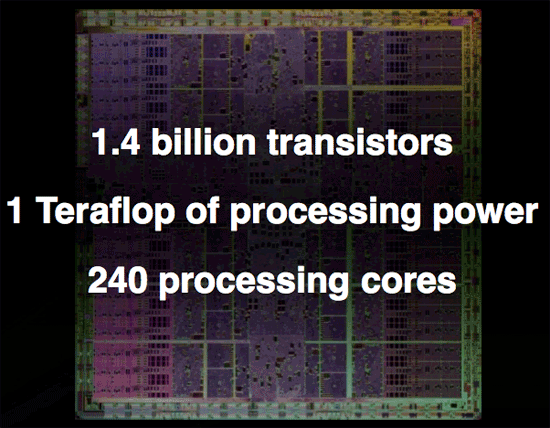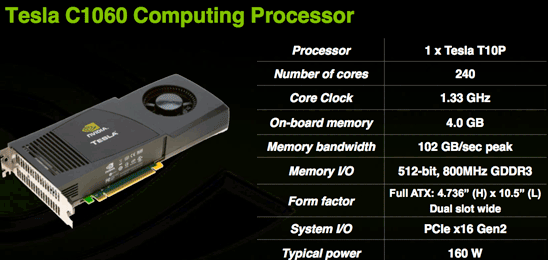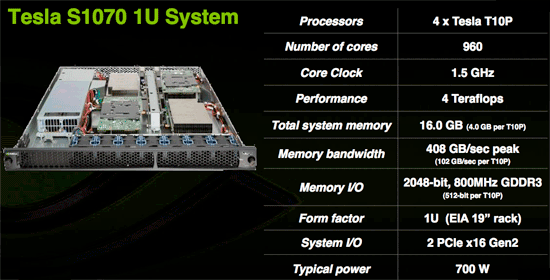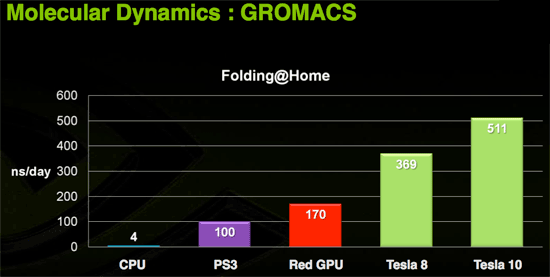NVIDIA's 1.4 Billion Transistor GPU: GT200 Arrives as the GeForce GTX 280 & 260
by Anand Lal Shimpi & Derek Wilson on June 16, 2008 9:00 AM EST- Posted in
- GPUs
Overclocked and 4GB of GDDR3 per Card: Tesla 10P
Now let's say that you want to get some real work done with NVIDIA's GT200 GPU but that 1.4 billion transistor chip just isn't enough. NVIDIA does have an answer for you, in the form of an overclocked GT200 with the 240 SPs running at 1.5GHz (up from 1.3GHz in the GTX 280) and with a full 4GB of GDDR3 memory on-board.

Today NVIDIA is also announcing their next generation Tesla product based on GT200 (called a T10P when used on Tesla for some reason). The workstation graphics guys will have to wait a while for a GT200 Quadro unfortunately. This new Tesla is similar to the older model in that it has much more RAM and no IO ports. The server version is also clocked higher than the desktop part because fan noise isn't an issue and data centers have lower ambient temperatures than some corner of an office under a desk.

The Tesla C1060 has an entire 4GB of RAM on board. This is obviously very large and will do well to accomodate the large scale scientific computing apps it is targeted at. This card is designed for use in workstations and is the little brother to the new monster server that is also being announced today.

The Tesla S1070 is a 1U server containing essentially 4 C1060 cards for a total of 16GBs of RAM on 960 SPs. This server, like the older version, connects to a server via a PCIe cable and is designed to run code written for CUDA at incredible speeds. With 120 double precision IEEE 754r floating point units in combination with the 960 single precision IEEE 754 units, this server is a viable option for many more projects than the previous Tesla hardware which was only capable of single precision floating point.
Though we don't have an application to benchmark the double precision floating point hardware on GT200 yet, NVIDIA states that a GT200 can roughly match an 8 core Xeon system in DP performance. This would put the S1070 on par with a 32 way Xeon setup at less than 700W. Needless to say, single precision code runs much much faster and can outpace hundreds of traditional CPUs in parallel.
While these servers are expensive (though we don't have pricing), they are cheap compared to the alternatives currently out there. The fact that CUDA code can be implemented and tested on any of the 70 million NVIDIA G80+ GPUs currently in people's hands means that developer already have a platform to test and debug code on before committing to the Tesla solution. On top of that, schools are beginning to adopt CUDA as a teaching tool for parallel computing. As CUDA gains acceptance and the benefits of GPU computing are realized, more and more major markets will take interest.
The graphics card is no longer a toy. The combination of CUDA's academic acceptance as a teaching tool and the availability of 64-bit floating point in GT200 make GPUs a mission critical computing tool that will act as a truly disruptive technology. Not only will many major markets that depend on high performance floating-point processing realize this, but every consumer with an NVIDIA graphics card will be able to take advantage of hundreds of gigaflops of performance from CUDA based consumer applications.

Today we have folding@home and soon we'll have Elemental's transcoder. Imagine the audio and video processing capabilities of a PC if the GPU were actively used in software like ProTools and Premier. Open source programs could easily best the processing capabilities of many solutions with dedicated hardware for these types of applications.
Of course, the major limiter to the adoption of this technology is that it is vendor specific. If NVIDIA put the time in (or enlisted help) to make CUDA an ANSI or ISO standard extention to a programming language, we would could really start to get excited. Beyond that, the holy grail would be a unification of virtualized instruction sets creating a standard low level "assembly" interface for GPU computing allowing CUDA to compile to one target and run on any graphics card. Sort of an x86 for massively parallel work.
Right now CUDA compiles to PTX, NVIDIA's virtual instruction set, and there is no reason someone couldn't write a CUDA compiler to target AMD's equivalent CAL (or even to develop a PTX to CAL wrapper that allowed AMD GPUs to run compiled CUDA code). Unfortunately, NVIDIA doesn't want to invest money and resources in extending functionality to AMD and AMD doesn't want to invest money and resources into bolstering an NVIDIA owned technology (that could theoretically radically change to cripple AMD's hardware support in future versions). While standards and cooperation are a great idea, the competition in this market is such that neither NVIDIA nor AMD are looking to take a chance on benefiting the consumer if there is any risk of strenthening the competition (even in spite of weakening the industry).










108 Comments
View All Comments
Anand Lal Shimpi - Monday, June 16, 2008 - link
Thanks for the heads up, you're right about G92 only having 4 ROPs, I've corrected the image and references in the article. I also clarified the GeForce FX statement, it definitely fell behind for more reasons than just memory bandwidth, but the point was that NVIDIA has been trying to go down this path for a while now.Take care,
Anand
mczak - Monday, June 16, 2008 - link
Thanks for correcting. Still, the paragraph about the FX is a bit odd imho. Lack of bandwidth really was the least of its problem, it was a too complicated core with actually lots of texturing power, and sacrificed raw compute power for more programmability in the compute core (which was its biggest problem).Arbie - Monday, June 16, 2008 - link
I appreciate the in-depth look at the architecture, but what really matters to me are graphics performance, heat, and noise. You addressed the card's idle power dissipation but only in full-system terms, which masks a lot. Will it really draw 25W in idle under WinXP?And this highly detailed review does not even mention noise! That's very disappointing. I'm ready to buy this card, but Tom's finds their samples terribly noisy. I was hoping and expecting Anandtech to talk about this.
Arbie
Anand Lal Shimpi - Monday, June 16, 2008 - link
I've updated the article with some thoughts on noise. It's definitely loud under load, not GeForce FX loud but the fan does move a lot of air. It's the loudest thing in my office by far once you get the GPU temps high enough.From the updated article:
"Cooling NVIDIA's hottest card isn't easy and you can definitely hear the beast moving air. At idle, the GPU is as quiet as any other high-end NVIDIA GPU. Under load, as the GTX 280 heats up the fan spins faster and moves much more air, which quickly becomes audible. It's not GeForce FX annoying, but it's not as quiet as other high-end NVIDIA GPUs; then again, there are 1.4 billion transistors switching in there. If you have a silent PC, the GTX 280 will definitely un-silence it and put out enough heat to make the rest of your fans work harder. If you're used to a GeForce 8800 GTX, GTS or GT, the noise will bother you. The problem is that returning to idle from gaming for a couple of hours results in a fan that doesn't want to spin down as low as when you first turned your machine on.
While it's impressive that NVIDIA built this chip on a 65nm process, it desperately needs to move to 55nm."
Mr Roboto - Monday, June 16, 2008 - link
I agree with what Darkryft said about wanting a card that absolutely without a doubt, stomps the 8800GTX. So far that hasn't happened as the GX2 and GT200 hardly do either. The only thing they proved with the G90 and G92 is that they know how to cut costs.Well thanks for making me feel like such a smart consumer as it's going on 2 years with my 8800GTX and it still owns 90% of the games I play.
P.S. It looks like Nvidia has quietly discontinued the 8800GTX as it's no longer on major retail sites.
Rev1 - Monday, June 16, 2008 - link
Ya the 640 8800 gts also. No Sli for me lol.wiper - Monday, June 16, 2008 - link
What about noise ? Other reviews show mixed data. One says it's another dustblower, others says the noise level is ok.Zak - Monday, June 16, 2008 - link
First thing though, don't rely entirely on spell checker:)) Page 4 "Derek Gets Technical": "borrowing terminology from weaving was cleaver" I believe you meant "clever"?As darkryft pointed out:
"In my opinion, for $650, I want to see some f-ing God-like performance."
Why would anyone pay $650 for this? Ugh? This is probably THE disappointment of the year:(((
Z.
js01 - Monday, June 16, 2008 - link
On techpowerups review it seemed to pull much bigger numbers but they were using xp sp2.http://www.techpowerup.com/reviews/Point_Of_View/G...">http://www.techpowerup.com/reviews/Point_Of_View/G...
NickelPlate - Monday, June 16, 2008 - link
Pfft, title says it all. Let's hope that driver updates widen the gap between previous high end products. Otherwise, I'll pass on this one.